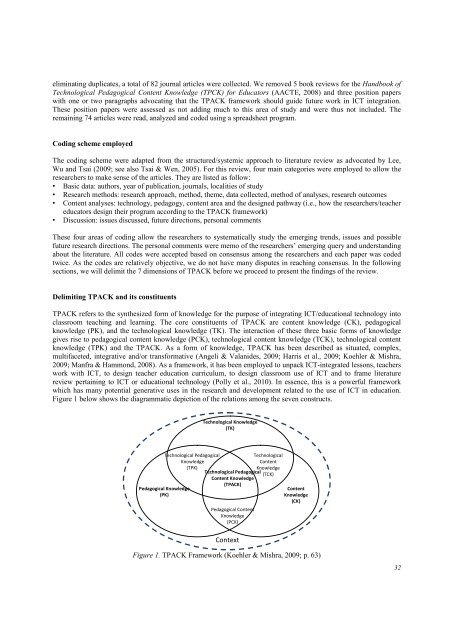Download Complete Issue in PDF - Educational Technology & Society
Download Complete Issue in PDF - Educational Technology & Society
Download Complete Issue in PDF - Educational Technology & Society
Create successful ePaper yourself
Turn your PDF publications into a flip-book with our unique Google optimized e-Paper software.
elim<strong>in</strong>at<strong>in</strong>g duplicates, a total of 82 journal articles were collected. We removed 5 book reviews for the Handbook of<br />
Technological Pedagogical Content Knowledge (TPCK) for Educators (AACTE, 2008) and three position papers<br />
with one or two paragraphs advocat<strong>in</strong>g that the TPACK framework should guide future work <strong>in</strong> ICT <strong>in</strong>tegration.<br />
These position papers were assessed as not add<strong>in</strong>g much to this area of study and were thus not <strong>in</strong>cluded. The<br />
rema<strong>in</strong><strong>in</strong>g 74 articles were read, analyzed and coded us<strong>in</strong>g a spreadsheet program.<br />
Cod<strong>in</strong>g scheme employed<br />
The cod<strong>in</strong>g scheme were adapted from the structured/systemic approach to literature review as advocated by Lee,<br />
Wu and Tsai (2009; see also Tsai & Wen, 2005). For this review, four ma<strong>in</strong> categories were employed to allow the<br />
researchers to make sense of the articles. They are listed as follow:<br />
• Basic data: authors, year of publication, journals, localities of study<br />
• Research methods: research approach, method, theme, data collected, method of analyses, research outcomes<br />
• Content analyses: technology, pedagogy, content area and the designed pathway (i.e., how the researchers/teacher<br />
educators design their program accord<strong>in</strong>g to the TPACK framework)<br />
• Discussion: issues discussed, future directions, personal comments<br />
These four areas of cod<strong>in</strong>g allow the researchers to systematically study the emerg<strong>in</strong>g trends, issues and possible<br />
future research directions. The personal comments were memo of the researchers’ emerg<strong>in</strong>g query and understand<strong>in</strong>g<br />
about the literature. All codes were accepted based on consensus among the researchers and each paper was coded<br />
twice. As the codes are relatively objective, we do not have many disputes <strong>in</strong> reach<strong>in</strong>g consensus. In the follow<strong>in</strong>g<br />
sections, we will delimit the 7 dimensions of TPACK before we proceed to present the f<strong>in</strong>d<strong>in</strong>gs of the review.<br />
Delimit<strong>in</strong>g TPACK and its constituents<br />
TPACK refers to the synthesized form of knowledge for the purpose of <strong>in</strong>tegrat<strong>in</strong>g ICT/educational technology <strong>in</strong>to<br />
classroom teach<strong>in</strong>g and learn<strong>in</strong>g. The core constituents of TPACK are content knowledge (CK), pedagogical<br />
knowledge (PK), and the technological knowledge (TK). The <strong>in</strong>teraction of these three basic forms of knowledge<br />
gives rise to pedagogical content knowledge (PCK), technological content knowledge (TCK), technological content<br />
knowledge (TPK) and the TPACK. As a form of knowledge, TPACK has been described as situated, complex,<br />
multifaceted, <strong>in</strong>tegrative and/or transformative (Angeli & Valanides, 2009; Harris et al., 2009; Koehler & Mishra,<br />
2009; Manfra & Hammond, 2008). As a framework, it has been employed to unpack ICT-<strong>in</strong>tegrated lessons, teachers<br />
work with ICT, to design teacher education curriculum, to design classroom use of ICT and to frame literature<br />
review perta<strong>in</strong><strong>in</strong>g to ICT or educational technology (Polly et al., 2010). In essence, this is a powerful framework<br />
which has many potential generative uses <strong>in</strong> the research and development related to the use of ICT <strong>in</strong> education.<br />
Figure 1 below shows the diagrammatic depiction of the relations among the seven constructs.<br />
Pedagogical Knowledge<br />
(PK)<br />
Technological Knowledge<br />
(TK)<br />
Technological Pedagogical<br />
Technological<br />
Knowledge<br />
Content<br />
(TPK)<br />
Knowledge<br />
Technological Pedagogical<br />
(TCK)<br />
Content Knowledge<br />
(TPACK)<br />
Pedagogical Content<br />
Knowledge<br />
(PCK)<br />
Context<br />
Content<br />
Knowledge<br />
(CK)<br />
Figure 1. TPACK Framework (Koehler & Mishra, 2009; p. 63)<br />
32

















